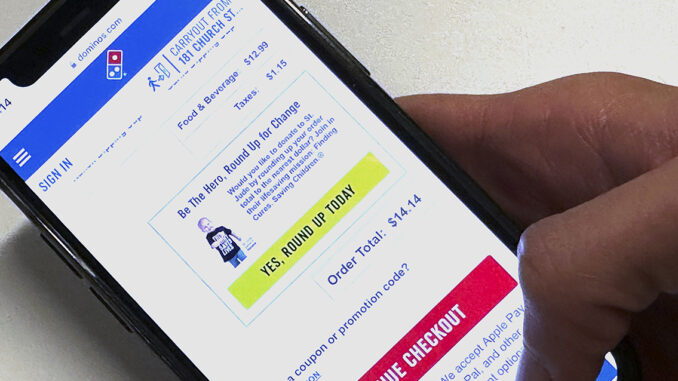
NEW YORK — The world’s top-selling pizza chain is betting big on the generosity of its customers. And it is not alone.
Domino’s recently pledged $174 million over the next 10 years to benefit St. Jude Children’s Research Hospital, expecting the funds to come from its longstanding roundup campaign that invites customers to donate the difference between their purchase total and the next-highest dollar amount. The pizza chain has already raised more than $126 million this way across the past two decades for ALSAC, the fundraising vehicle for the Tennessee-based hospital.
Domino’s is the latest and largest example of “checkout charity” success. The fundraising tool raked in 24% more money in 2022 than 2020 among the highest-making programs for a total of $749 million, according to the professional association Engage for Good.
That staying power has franchises hopeful that consumers will continue giving their spare change despite shifts toward online shopping, negative economic headwinds and fears that more frequent solicitations will cause fatigue. Meanwhile, some retailers are fleshing out partnerships first formed after the 2020 racial reckoning pushed corporate citizenship toward the forefront of business practices.
Studies suggest that asking customers to round up is generally more effective than requesting a fixed amount — even when the totals are the same. That’s because the framing lessens the sting of parting with one’s money, according to a paper published in the Journal of Consumer Psychology.
“It feels less painful,” said Katie Kelting, a Saint Louis University marketing professor who led the research team.
The timing of the appeal introduces several other psychologically potent factors, according to Ike Silver, a marketing professor at Northwestern University. Buyers tend to imagine their purchases in whole numbers anyway; a $24.75 bill codes as $25, for example.
Plus, Silver said, it makes the act of giving “a bit more mindless.” Shoppers rushing to get through the checkout line don’t have much time to consider reasons against the donation.
“They capitalize on a purchase inertia where you’re just spending your money and you’re not really thinking too much about it,” Silver said.
Champions of the strategy credit the asks for engaging everyday, would-be donors in an approachable form of giving with low barriers to entry. The practice is so commonplace that shoppers’ cumulative gifts have even become a key funding stream for some issue areas.
REI Co-op, a specialty outdoor clothing and equipment seller, launched its member-supported public charity in 2021 to help make outdoor spaces more inclusive. The goal was to put more resources into the surrounding communities coming out of COVID-19 shutdowns.
At its 185 U.S. locations, sales associates often strike up personal conversations with customers and are supposed to leave the conversation with an open-ended ask that lets customers decide whether to round up or donate an amount of their choosing. About $2.2 million from 1.3 million individual donations were raised in stores last year, according to Simpson.
Still, some observers are worried that even the best of intentions won’t keep the spigot from stopping as like-minded programs pop up in checkout lines around the country. Silver, the Northwestern University professor, questions whether the effectiveness of “checkout charity” will wane with its popularity.
“If it’s really something that’s coming up every time you swipe your card, one risk is people start to notice that and feel a bit more manipulated,” he said.
Misinformation does not help either. Contrary to popular internet posts, tax policy experts say that stores can’t write off customers’ point-of-sale donations because they don’t count as company income.
Domino’s leaders remain confident in their fine-tuned strategy. With the iconic St. Jude child printed on Domino’s pizza boxes, the established partners are already among the most recognizable when it comes to point-of-sale donations.
Domino’s raised $8.9 million last year through roundup. Its leadership believes that number will increase under a new five-year strategy to grow its customer base.
Described by CEO Russell Weiner as “an audacious goal” that isn’t necessarily a “slam dunk,” the high-dollar charitable commitment adds another motivator to meet its latest nonprofit benchmarks.
ALSAC CEO Rick Shadyac said the extra Domino’s funding will help St. Jude’s efforts to triple the survival rate for children with the six most common forms of childhood cancer in 80 countries. That includes this summer’s rollout of a program that will eventually provide free cancer medications to 30% of the 400,000 children around the world with the disease.
“If we drive more sales and more stores, what does that mean? That means we have more customers,” Weiner said. “The better we do there, the more people we’ve got that we can raise money for St. Jude.”
